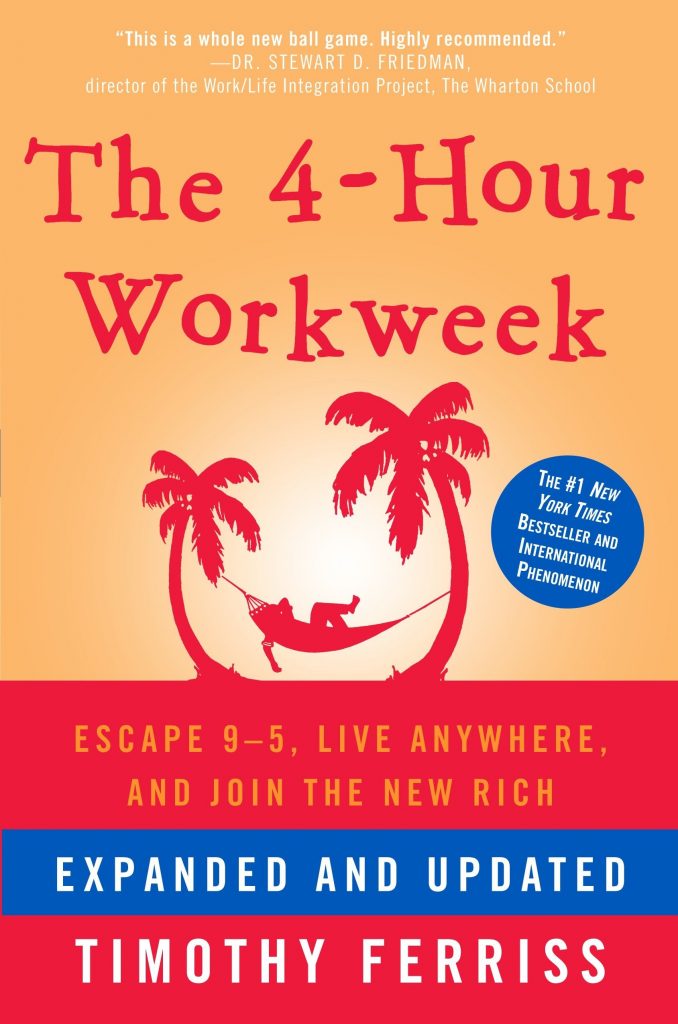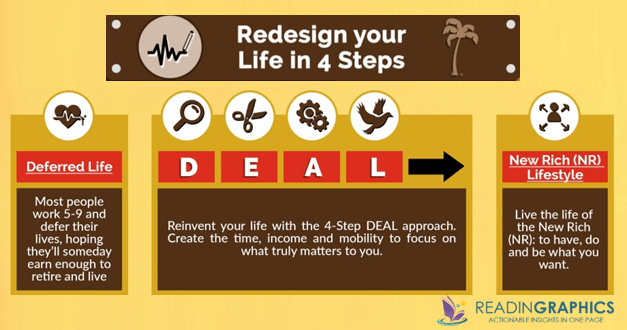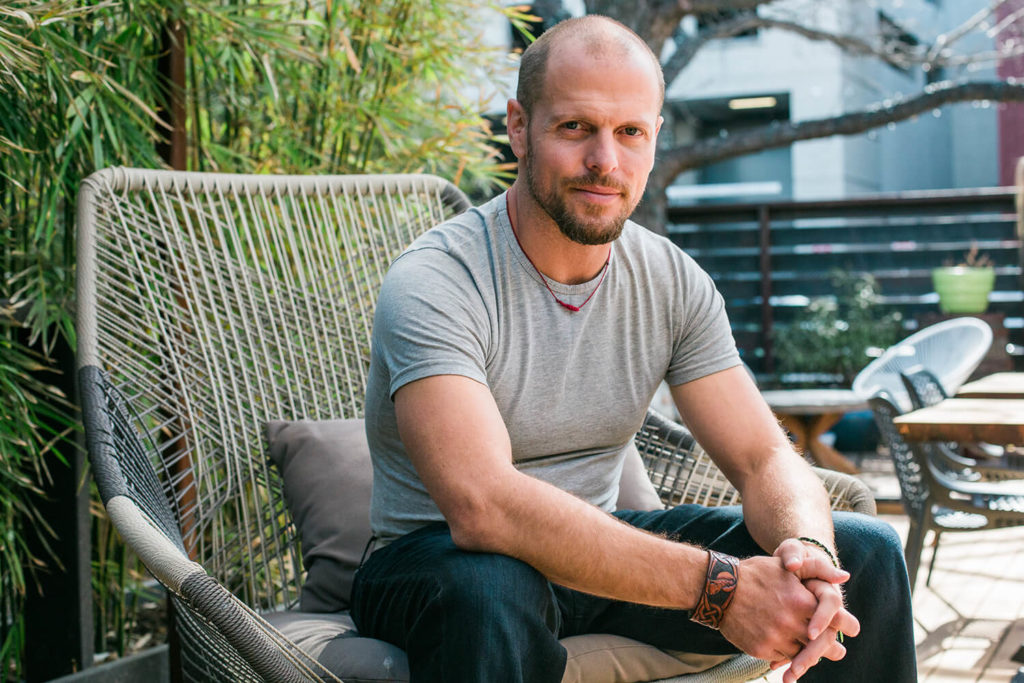
Do well in school, finish college, and land a high-paying 9-to-5 job. That is basically the default formula for success, right?
Well, what if there was an easier way? Is it worth trying out, or are the risks too high? In the book The 4 Hour Work Week, Tim Ferriss argues that anyone can potentially skip the traditional 9-to-5.
In this book, Ferriss lays out this radical picture of working for just 4 hours a week and spending the rest of your days on vacation.
Naturally, this seemed too good to be true and was met with some skepticism. While many readers of the book attest to its life-changing message, some maintain that it’s just a gimmick.
This summary handpicks the gems and filters out the exaggerations to give you only the important details. If you are interested in finding out whether or not the 4 Hour Work Week is your next gamechanger, read along.
The 4 Hour Work Week: New Rich
“Escape 9-5, live anywhere, and join the new rich.” That is the catchphrase Tim Ferriss used to market the 4-hour Work Week idea. For starters, it is important to understand what Ferriss means by “The New Rich.”
According to Ferriss, there are two types of people—the NR and the D—the New Rich and the Deferrers. The latter is the group where most people fall in, they believe that one has to work for 40 years of his life in order to enjoy a wonderful retirement.
These people are called the Deferrers because they live with a deferred life plan. They are trapped in the notion that life is about pushing back all the exciting vacations and around the world trips up until retirement and choosing to work 8 hours a day.
The New Rich, on the other hand, are those who are freed from the shackles of traditional work setup; those who make a lot of money for a few hours of work. As Ferriss puts it, “[The New Rich] achieve 90% of the results in one-tenth of the time.”
Now, it is important to tread carefully with the idea of the New Rich. The 4 Hour Work Week emphasizes that by no means are the New Rich the wealthiest in the world in monetary terms. However, they achieve most of their work in the least amount of time, leaving their excess hours to do with as they please.
Tim Ferriss breaks down the process of joining the New Rich into 4 steps—Definition, Elimination, Automation, and Liberation. Abbreviated as DEAL, this 4-step process presents the idea of being a “deal maker” in every situation.
As Tim Ferriss claims, “reality is negotiable”. There are plenty of advantageous steps one can take in order to twist and bend the rules without resorting to unethical means. These strategies are what he imparts in the 4 Hour Work Week.
Step 1: D is for Definition
In past generations, people were paid fixed amounts of money for their hourly work. While this is still true up to this day, there are a handful of new tools that anyone can utilize to multiply their productivity.
These tools, such as the internet, smart gadgets, and other modern services, comprise the backbone that makes the ideas in the 4 Hour Work Week possible. It is important to realize that with new tools such as these a new game is born, and a new game entails a new set of rules.

In the first step of building up a 4-hour workweek, Tim Ferriss redefines the rules of the productivity game. It is where he pointed out the main differences between the New Rich and the Deferrers before proceeding with the three main ingredients of the 4-hour workweek. The following are the most important points in Step 1:
- Who are the New Rich?
The New Rich are the employees who set up a fixed schedule and pair it with an efficient workflow to accomplish a pile of work within a fraction of time. They are people who end up having a lot of free time for road trips and vacations.
The New Rich are the businessmen who focus their strength and energy on the most profitable clients. They outsource operations and work remotely anywhere they please.
Anyone who nails the essentials and automates the work, all while freeing up precious time belongs to the New Rich.
- Retirement is an Insurance
The 4 Hour Work Week argues that retirement should be viewed as insurance rather than a pot of gold at the end of the rainbow. To adapt to the new rules quickly, one should scrap the idea that retirement is the main event. It is not. According to Ferris,
[it is merely] a hedge against the absolute worst-case scenario: in this case, becoming physically incapable of working and needing a reservoir of capital to survive.
- “Mini-retirements”
The NR’s mindset is to scatter a lot of “mini-retirements” throughout life. This is achievable by mindfully choosing to work when one is most effective. Ferriss metaphorically puts this as: “It’s the perfect example of having your cake and eating it, too.”
- Less is Not Laziness
Most people measure their productivity in terms of the number of hours of work. This is reasonable because of the notion of getting paid per hour; however, this is not how the new rules work.
Busyness does not automatically entail productivity. Rather than focusing on working for longer, focus on accomplishing more in a shorter period. Ditch the non-essentials and focus on what truly matters.
- Relative Income is more important than Absolute Income
Absolute income is what you make in terms of dollars, while relative income takes time into account. If there are two entrepreneurs who both make $100,000 a year, they are on par with each other in terms of absolute income.
However, if the first one works 5 hours a week while the other works for 40, it is easier to see how much richer the first one is. The 4 Hour Work Week suggests you view things from this perspective.
- Important actions are uncomfortable
To fully achieve the benefits of the 4-hour work week, Tim Ferris asserts that one must learn to seek comfort with the uncomfortable. It is by doing so that one becomes equipped with life-changing actions.
In the book, it is also suggested to practice familiarity with uncomfortable situations through an eye-gazing exercise. The exercise is comprised of simply maintaining eye contact with people you converse with.
Step 2: E is for Elimination
The 4 Hour Work Week lives by one of the quotes of author Antoine De Saint-Exupery, which states that “perfection is not when there is no more to add, but no more to take away.” This chapter of the book focuses on stripping away the non-essentials of work.
Tim Ferriss claims that busyness is often used as a reason to avoid confronting the most important actions (which happens to be the most uncomfortable ones, too). While staying “busy” in a traditional corporate setting might show that you work hard, this is not true for the New Rich.
Furthermore, the book states that it is not just possible to accomplish more by doing less, rather it is mandatory. Here are some of the most notable takeaways in Step 2:
- Being effective differs from being efficient
A person who has developed an incredibly sophisticated way of checking 500 emails a day is efficient; however, he may not be effective. A door-to-door salesman who visits 30 houses a day is also efficient, but his effectiveness is not guaranteed.
Tim Ferriss summarizes this idea into 2 key points to remember: First, doing unimportant work does not make it important, and second, requiring a lot of time does not make a task important.
With these ideas in mind, you must question your own workflow: Are you working effectively?
- Pareto’s Law
Vilfredo Pareto is a controversial economist-cum-sociologist who developed the 80/20 principle, also known as Pareto’s law. This was derived from his pea garden experiment where he found out that 80% of produce came from 20% of the peapods.
This principle is also present in the distribution of wealth in the society—80% of wealth is owned by 20% of the population. Furthermore, the same thing can be said with work: 80% of outputs result from 20% of inputs.
There are other ways the book puts this as well:
- 80% of results come from 20% of the effort and time
- 80% of company profits come from 20% of the products and customers.
- Some questions to ask yourself
In order to eliminate everything down to the bare essentials of work, the 4 Hour Work Week includes some thought-provoking yet sensible guide questions to ask yourself. The following are examples:
- Am I being productive or just active?
- Am I inventing things to do to avoid the important?
- If you had a heart attack and had to work two hours per day, what would you do?
- What are the top three things that I use to fill time to feel as though I’ve been productive?
- If this is the only thing I accomplish today, will I be satisfied with my day?
These questions are designed to challenge you and get you to pinpoint exactly which work brings you the most reward. Differentiating between essential and unessential work is a habit of the New Rich.
- Ignorance can be practical
In one of the chapters of the 4 Hour Work Week, The Low-Information Diet, Tim Ferriss presents yet another radical idea: that ignorance can be practical. In fact, Tim recommends that his readers practice the art of being willfully ignorant in certain situations, where being knowledgable would cause stress and unhappiness.
This can be done by first maintaining a low-information diet. Information consumes the attention of its recipients thus creating a scarcity of attention to more important matters.
It is important to be selective in what one consumes. Similar to how modern man consumes too many empty food calories, Deferrers tend to consume many irrelevant “information calories”. For this reason alone, you must be convinced to cultivate selective ignorance.
Step 3: A is for Automation
Think back for a second and imagine how much time a washing machine saves you. If the cost per wash is doubled, would you still use your washing machine? Chances are you still would.
This is a simple example of how machines greatly free up your valuable time. It might sound like a ridiculous example, but it best puts into perspective the possibility of trading a small amount of cash with some invaluable and irreplaceable free time.
Now, imagine there’s a machine to automate work for you. Chances are if such a machine existed you would love to get your hands on it!
In the 4 Hour Work Week, Tim Ferris claims that there is such a thing, and that machine goes by the term “outsourcing.”
The book cites the promising account by Esquire magazine editor, AJ Jacobs who had his entire career automated. The 4 Hour Work Week shows how the same thing can apply to you.
Regardless of whether you are an employee or an employer, outsourcing will work to your advantage. It is a necessary step in joining the New Rich. Here are some key points in Step 3:
- Automation amplifies
Before outsourcing your entire life, it is worth noting one general rule of technology used in business. As Bill Gates puts it,
“[the first rule is] automation applied to an efficient operation will magnify efficiency, [the second is that] automation applied to an inefficient operation will magnify the inefficiency.”
Before delegating your tasks, make sure that you have already eliminated the unimportant. This is the reason why elimination comes in step 2 before automation is step 3.
It is important to keep in mind, quoting Tim Ferriss, “—unless something is well-defined and important, no one should do it.”
- Anything can be outsourced
Many people often ask what they should outsource. The answer? EVERYTHING.
Tim Ferriss attests to this by citing tons of examples in his book. From sending prank e-mails to your co-workers to harassing your boss by paying someone to send fake calls, anything can be outsourced. Creating documents, financial research, website development, everything is on the outsourcing menu.
- “Get an assistant—even if you don’t need one.”
This phrase is how Ferriss worded one of his suggested actions in how one should start with outsourcing. He claims that one should get the habit of commanding and not being commanded.
Start with something small, get someone to do repetitive tasks for you. This is where the magic of third-world countries comes in. There are plenty of virtual assistants in India or the Philippines who communicate well and charges less than $5 an hour, use this to your advantage.
Having trouble hiring one? Here’s a review of how to use Onlinejobs.ph to hire a Virtual Assistant quickly and painlessly.
- Income Autopilot
Three sections of the book focused on generating income on autopilot. The idea behind an income autopilot resonates with the modern-day notion of a “passive income.” As Ferriss says, the best way for many to get automated income is to start an online business.
He also argues that the most accurate indicator of whether your business idea will thrive is to actually sell it to people. Commercial viability is best tested in the actual marketplace.
Summed up in four general steps, setting up an income autopilot entails:
- Market Selection
- Product Brainstorm
- Micro-Testing
- Rollout and Automation
- Management by Absence (MBA)
Management by Absence is another radical idea from the 4 Hour Work Week. While most business gurus are split between treating your employees gently or firmly, Ferriss’s take is different.
He suggests that you “remove the human element” entirely. In his own words, “once you have a product that sells, it’s time to design a self-correcting business architecture that runs itself.”
The gist of Management by Absence is removing yourself from the equation. In designing an income autopilot, you must keep in mind that you must design it around the idea of scalability; you should not be an essential ingredient.
Step 4: L is for Liberation
Liberation is the fourth and final step in joining the New Rich and fully escaping the 9-to-5. This step talks about how you can bargain a work-from-home set up with your employer, how to embrace a mobile lifestyle, and everything in between.
- Escaping the Office
In the book, an interesting case study was performed by a character named Sherwood—a trusty company worker. Sherwood started the experiment by first ensuring that the company invests more in him.
He does this by performing step 1 of escaping the office: Increase Investment. This basically means to put a higher price on himself, making him a prized possession in the firm. Sherwood did so by proposing a company-paid four-week industrial design class which he will manage.
After a couple of days upon approval, he strategically calls in sick. Transitioning to step 2 of escaping the office: Prove Increased Output Offsite, Sherwood completes the work effectively despite working from home.
Afterward, he moves into step 3: Prepare the Quantifiable Business Benefit. He listed out his arguments and laid out how his employer can benefit from this work-from-home setup.
Sherwood then takes the 4th step: Propose a Revocable Trial Period. He bargains with his boss a trial work-from-home setup, where he pointed out the possible benefits for the business.
Finally, Sherwood closes with step 5: Expand Remote Time, where he bargains for more time working remotely. He, of course, laid out his argument in terms of how the company will benefit.
- Environment-free Productivity
Before fully embarking on a trip to the Bahamas to enjoy your newfound remote work setup, you must ensure that you can literally work anywhere.
For practice, the 4 Hour Work Week suggests that you attempt to work for two to three hours in a local cafe. If you lift weights at the gym, try working out at home.
The idea is to accomplish the same amount regardless of the environment. This is an invaluable skill that you will need on your way to becoming the New Rich.
- Embracing the Mobile Lifestyle
If you have successfully executed all the prior steps in the 4 Hour Work Week, indulging the world is your next. Embracing the mobile lifestyle is analogous to reaping the rewards of successfully joining the new rich.
Tim Ferriss suggests that you should plan out your “mini-retirements” and shed the fear of traveling. Whether it’s the whereabouts of your children that’s holding you back or the price of airfare, there is always a solution and absolutely no valid excuse not to travel.
Whether you are planning to be out for two months, two weeks, or two days, there are nifty guides in the book to help you keep track of all the essential things to do.
- How to Fill the Void
During the early days of liberation, you will definitely feel a void. This is a result of being freed from the shackles of having a lot of things to do. As Ferriss puts it, “Postpartum Depression: It’s Normal.”
The book claims that being bored and feeling useless in the first couple of days is what high-performers would feel when they experience a sudden downshift in workload.
Without the distracting deadlines and noisy co-workers, one might have more time to contemplate bigger life questions (such as existential ones). In this case, Tim Ferriss suggests one embark on continual learning and acts of service.
The 4-hour Work Week: Lifehack or Gimmick?

If you decide to read the entirety of the 4 Hour Work Week, you will find some passages and real-life examples a bit idealistic and gimmicky. You might even utter something along the lines of, “there is no way, this will work for me.”
However, it is important to realize that the book, let alone its title, is not coming from a literal standpoint. It does not claim nor guarantee that you will achieve the optimal results right away. Rather, it shows you how to get there; how the New Rich do it.
Sometimes, a peek at how others practice radical ideas sparks new ways that you can implement some of them within your own workflow, and this is exactly what the book does very well. For this reason, I would say that the 4 Hour Work Week is more of a promising lifehack rather than an idealistic gimmick.

Recommended Reading
How to Hire and Train Virtual Assistants From The Philippines
Are you ready to grow your business, but have no idea how to hire a Virtual Assistant? This guide explains the complete process step by step.
25 Cool And Memorable Ideas for Bar and Bat Mitzvah Gifts
Looking for the best, most appropriate Bar Mitzvah gifts possible for a Jewish boy? Look no further! Here are 25 great ideas to choose from.
Onlinejobs.ph Reviews: Cheap Virtual Assistants from the Philippines
Trying to hire a Virtual Assistant? Try Onlinejobs.ph! Read on for the most comprehensive, up to date Onlinejobs.ph review you can find.
Escape Burnout: The Best Methods
Trying to escape burnout, but you aren't sure where to start? Check out this article and start the burnout healing process now!

